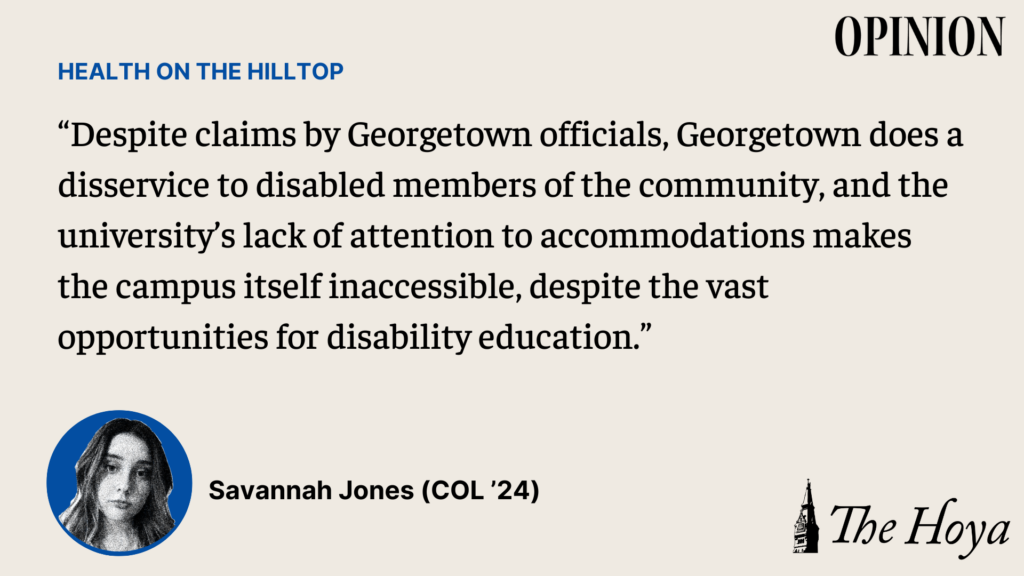Georgetown University offers a plethora of opportunities for disability education, but when it comes to taking action to make campus accessible for those living with physical disabilities, Georgetown falls remarkably short.
Georgetown’s disability studies program offers an undergraduate minor and graduate-level certificates for students to learn more about disability theory and various models of disability and ableism. Classes in bioethics and philosophy of disability are provided alongside the university’s “engaging diversity” core degree requirement. Outside the classroom, physically disabled students do not receive adequate accommodations when it comes to campus accessibility. Despite claims by Georgetown officials, Georgetown does a disservice to disabled members of the community, and the university’s lack of attention to accommodations makes the campus itself inaccessible, despite the vast opportunities for disability education.
In a February 2022 article published in The Hoya, the university affirmed its commitment to serving disabled populations within Georgetown, following claims that campus was inaccessible in a previous article. In reality, the physical conditions of the university — detailed in pictures of its undergraduate campus, which are featured in the online edition of this article — reaffirm the fact that accessibility falls on the administrative backburner. Physical disabilities require special accommodations; ramps, door access buttons, elevators, lifts; across campus, some of these accommodations have been unavailable to physically disabled students for extended periods, leaving handicapped Georgetown students and employees without the support they need to navigate their place of school or work.
Members of Georgetown’s disabled population — wheelchair users, in particular — face physically limiting conditions on campus, especially with regard to campus doors, which can cause accessibility issues in classrooms, dorms and community spaces. The automatic buttons in the Leavey Center and Regents Hall frequently do not work to open the doors, which, in the case of these two buildings in particular, are extremely heavy. Disability access buttons are required under the Americans with Disabilities Act (ADA), and ADA guidelines for public institutions are used as the groundwork for conversations about accessibility. If Georgetown cannot meet the same baseline requirements as public peer institutions, it seems dishonest for the university to claim itself a proponent of accessibility.
It is reasonable that some buildings, like the Alumni Square and Henle Village dorms, would not contain elevators, given that there are a variety of other options for handicapped students. Since they are confined to certain housing options, students with physical limitations should expect to be accommodated in the spaces that are made for them, but this is not the case. For example, disability buttons for the doors in Pedro Arrupe, S.J. Hall, a campus dormitory, were visibly broken for over a week this semester. Buttons across campus that appear to be functional do not open the door, even when the student has scanned in with their GoCard.
Georgetown’s main campus ADA statement promises accessible options for disabled students, stating the university’s commitment to accessibility for students with disabilities with regards to its programs, facilities, services, and activities. In the same statement, the university assures students that no discrimination should occur towards disabled students. However, in many cases, the university has not created an accessible environment for all students to move freely and easily. In the alternative pathway through the Leavey Center parking garage, which includes patient parking for the Lombardi Comprehensive Cancer Center, a ramp leading to one of the exit doors, which was broken earlier this semester, is now non-existent, and both exits lack disability access buttons. This is disheartening, especially given that handicapped parking is directly adjacent to these exits, meaning that people with physical disabilities who require allocated parking, especially those in wheelchairs, are not able to access doors leading to campus medical facilities.
It is important that Georgetown’s students and administrators pay attention to the problems that the community’s disabled population faces on campus. Statements by the Georgetown administration are not enough to create accessibility when they are not followed by tangible action. A higher standard for maintenance, including more frequent inspections, special maintenance reports and new installations for disability access buttons and ramps would allow the community to better accommodate those who live with physical limitations.
Issues with accessibility to campus buildings, as well as disregard for people with disabilities, belies the university’s commitment to support of its disabled students, faculty and staff. It is the responsibility of all members of the Georgetown community, especially the university administration, to take real steps to make space for those who require accommodations to live, work and study at Georgetown.
Savannah Jones is a junior in the College. Health on the Hilltop appears in print and online every third Friday.














